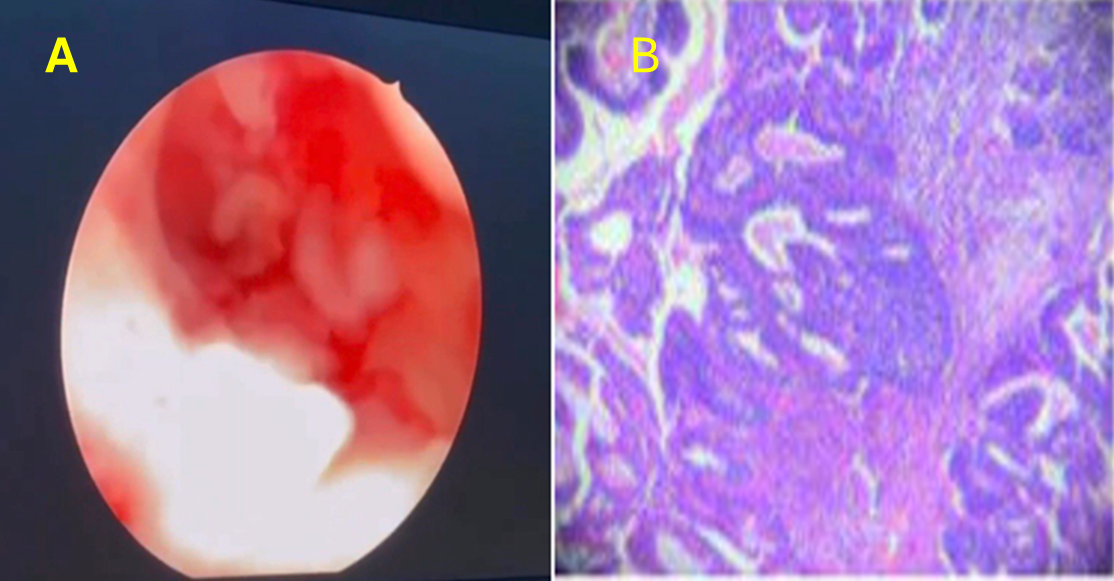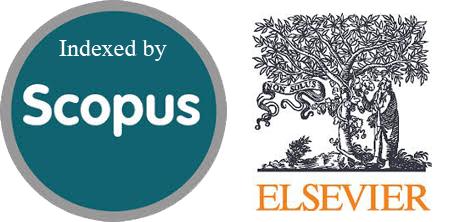Hysteroscopic Evaluation of Postmenopausal Bleeding
DOI:
https://doi.org/10.54133/ajms.v9i2.2360Keywords:
Hysteroscopy, Histopathology, Postmenopausal bleedingAbstract
Background: Postmenopausal bleeding (PMB) is a common gynecological condition presented to national health institutes, and assessing the exact reason for postmenopausal bleeding is essential to detect the emergency status and to plan appropriately for management. For that, diagnostic technology is crucial in PMB. Hysteroscopy has proven to be a useful tool in visualizing and identifying common causes of PMB. Objective: To evaluate the role of hysteroscopy in identifying the most common causes of PMB and correlate clinically with histopathological findings. Methods: A cross-sectional study was conducted in the period from March 1, 2019, to February 28, 2025, involving 80 women with symptomatic ongoing postmenopausal bleeding who had been referred to hysteroscopy. Information was gathered from patient-based questionnaires, in addition to hysteroscopy and histopathology findings. Results: Most women were aged 50–59 years (51.2%), had a parity of ≥5 (62.5%), were overweight or obese (86.3%), and had been menopausal for ≤10 years (51.2%). Hysteroscopy detected abnormalities in 97.5% of cases. Histopathology confirmed abnormal findings comprising polyps (36.3%), hyperplasia (18.7%), submucous fibroids (16.3%), atrophic endometrium (15%), and endometrial adenocarcinoma (10%). Increased age was significantly associated with malignant lesions (p<0.001). Hysteroscopy showed high diagnostic accuracy for endometrial polyps (98.7%), submucous myoma (100%), atrophic endometrium (93.7%), and irregular growth (97.5%), but lower accuracy for polypoidal endometrium (71.2%). Conclusions: Hysteroscopy is a reliable and useful tool in visualizing the causes of postmenopausal bleeding and has shown that endometrial polyps are the most common cause of PMB.
Downloads
References
Carugno J. Clinical management of vaginal bleeding in postmenopausal women. Climacteric. 2020;23:343-349. 20200401. doi: 10.1080/13697137.2020.1739642. DOI: https://doi.org/10.1080/13697137.2020.1739642
Santoro N, Roeca C, Peters BA, Neal-Perry G. The Menopause transition: Signs, symptoms, and management options. J Clin Endocrinol Metab. 2021;106:1-15. doi: 10.1210/clinem/dgaa764. DOI: https://doi.org/10.1210/clinem/dgaa764
Giannella L, Mfuta K, Setti T, Cerami LB, Bergamini E, Boselli F. A risk-scoring model for the prediction of endometrial cancer among symptomatic postmenopausal women with endometrial thickness > 4 mm. Biomed Res Int. 2014;2014:130569. doi: 10.1155/2014/130569. DOI: https://doi.org/10.1155/2014/130569
Ali S, Sattar Salih H, Saadoon N. Exploring women's challenge to Pap smear attendance and colposcopy referral: A qualitative study. Malaysian J Med Health Sci. 2022;18:150-155. doi: 10.47836/mjmhs18.4.21. DOI: https://doi.org/10.47836//mjmhs18.4.21
Ali SM, Clark MT, Khedher Ghalib A, Skirton H. Donaldson C. "We don't have up to date knowledge about the disease" Practical challenges encountered in delivery of cervical cancer screening in Iraq. Eur J Cancer Care (Engl). 2021;30:e13457. doi: 10.1111/ecc.13457. DOI: https://doi.org/10.1111/ecc.13457
Akram A. Risk factors and prevalence of osteoporosis amidst postmenopausal females turning up the diabetes and endocrinology clinic at Azadi Teaching Hospital at Kirkuk /Iraq. Kirkuk J Med Sci. 2022;10:160-72. doi: 10.32894/kjms.2022.174641. DOI: https://doi.org/10.32894/kjms.2022.174641
Kumari K, Paswan MK, Kundan M, Ambedkar SN. A prospective study of endometrial histopathology in post-menopausal women in Jharkhand. J Family Med Prim Care. 2024;13:1696-700. doi: 10.4103/jfmpc.jfmpc_1331_23. DOI: https://doi.org/10.4103/jfmpc.jfmpc_1331_23
Ibrahim RO, Omer SH, Fattah CN. The Correlation between hormonal disturbance in PCOS women and serum level of kisspeptin. Int J Endocrinol. 2020;2020:6237141. doi: 10.1155/2020/6237141. DOI: https://doi.org/10.1155/2020/6237141
Burbos N, Musonda P, Giarenis I, Shiner AM, Giamougiannis P, Morris EP, et al. Predicting the risk of endometrial cancer in postmenopausal women presenting with vaginal bleeding: the Norwich DEFAB risk assessment tool. Br J Cancer. 2010;102:1201-1206. doi: 10.1038/sj.bjc.6605620. DOI: https://doi.org/10.1038/sj.bjc.6605620
Abdul Hasan M, Hashimi B, Qasim A, Al Ameen M. Prevalence of abnormal Pap smears among sample of Iraqi women attending Al Elweiya cervical screening unit in Baghdad. J Cardiovasc Dis Res. 2020;11:120-124. doi: 10.31838/jcdr.2020.11.02.18.
Van den Bosch T. Ultrasound in the diagnosis of endometrial and intracavitary pathology: an update. Australas J Ultrasound Med. 2012;15:7-12. doi: 10.1002/j.2205-0140.2012.tb00135.x. DOI: https://doi.org/10.1002/j.2205-0140.2012.tb00135.x
ACOG Committee Opinion No. 734: The Role of transvaginal ultrasonography in evaluating the endometrium of women with postmenopausal bleeding. Obstet Gynecol. 2018;131:e124-e29. doi: 10.1097/aog.0000000000002631. DOI: https://doi.org/10.1097/AOG.0000000000002631
Dimitraki M, Tsikouras P, Bouchlariotou S, Dafopoulos A, Liberis V, Maroulis G, et al. Clinical evaluation of women with PMB. Is it always necessary an endometrial biopsy to be performed? A review of the literature. Arch Gynecol Obstet. 2011;283:261-266. doi: 10.1007/s00404-010-1601-3. DOI: https://doi.org/10.1007/s00404-010-1601-3
Cooper NA, Barton PM, Breijer M, Caffrey O, Opmeer BC, Timmermans A, et al. Cost-effectiveness of diagnostic strategies for the management of abnormal uterine bleeding (heavy menstrual bleeding and post-menopausal bleeding): a decision analysis. Health Technol Assess. 2014;18:1-201, v-vi. doi: 10.3310/hta18240. DOI: https://doi.org/10.3310/hta18240
Shen Y, Yang W, Liu J, Zhang Y. Minimally invasive approaches for the early detection of endometrial cancer. Mol Cancer. 2023;22:53. doi: 10.1186/s12943-023-01757-3. DOI: https://doi.org/10.1186/s12943-023-01757-3
Trojano G, Damiani GR, Casavola VC, Loiacono R, Malvasi A, Pellegrino A, et al. The role of hysteroscopy in evaluating postmenopausal asymptomatic women with thickened endometrium. Gynecol Minim Invasive Ther. 2018;7:6-9. doi: 10.4103/gmit.Gmit_10_17. DOI: https://doi.org/10.4103/GMIT.GMIT_10_17
Omar AA, Seham A, Al-Kharabsheh AM, Alshara E, Sindiani AM, Hamdan O, et al. Clinical and sonographic evaluation of postmenopausal bleeding (PMB) followed by diagnostic and/or therapeutic hysteroscopy and guided biopsy in Jordanian hospitals. Medicina (Kaunas). 2020;56. doi: 10.3390/medicina56040147. DOI: https://doi.org/10.3390/medicina56040147
Raheem A, Ghafel H. Evaluation of bleeding characteristics among menopausal women at maternity hospitals in Baghdad city. Kufa J Nurs Sci. 2021;11:1-12. doi: 10.36321/kjns.vi20211.474. DOI: https://doi.org/10.36321/kjns.vi20211.474
Abdollahi AA, Qorbani M, Asayesh H, Rezapour A, Noroozi M, Mansourian M, et al. The menopausal age and associated factors in Gorgan, Iran. Med J Islam Repub Iran. 2013;27:50-56.
Liu F, Cheung ECW, Lao TT. Obesity increases endometrial cancer risk in Chinese women with postmenopausal bleeding. Menopause. 2021;28:1093-1098. doi: 10.1097/gme.0000000000001822. DOI: https://doi.org/10.1097/GME.0000000000001822
Talwar S, Kaur H, Tapasvi I, Nibhoria S, Tapasvi C. Clinical and histopathological characteristics in women with postmenopausal bleeding: A study of 120 women in a tertiary care hospital in Punjab. Cureus. 2024;16:e51690. doi: 10.7759/cureus.51690. DOI: https://doi.org/10.7759/cureus.51690
Mansingh S, Dhillon A, Sood S, Anne S, Godi P. Hysteroscopic evaluation of postmenopausal bleeding patients and its correlation with histopathological examination. Int J Reprod Contracept Obstet Gynecol. 2020;9:3215. doi: 10.18203/2320-1770.ijrcog20203298. DOI: https://doi.org/10.18203/2320-1770.ijrcog20203298
Hamood MA. The role of hysteroscopy in diagnosis of suspected endometrial pathology and its histopathological correlation. Int J Clin Obstet Gynaecol. 2019;3:37-42. doi: 10.33545/gynae.2019.v3.i5a.328. DOI: https://doi.org/10.33545/gynae.2019.v3.i5a.328
Al Adami MS, Al Taie ID. Diagnostic hysteroscopy versus diagnostic curettage for evaluation of endometrial pathology in patients with abnormal uterine bleeding. J Fac Med Baghdad. 2010;51:361-364. doi: 10.32007/jfacmedbagdad.5141081. DOI: https://doi.org/10.32007/jfacmedbagdad.5141081
Flayah MJ, Hussein AG. Clinicopathological assessment of postmenopausal bleeding in a sample of Iraqi patients. Iraqi Postgrad Med J. 2024;23:73-80. doi: 10.52573/ipmj.2024.183106. DOI: https://doi.org/10.52573/ipmj.2024.183106
Khademi K, Kaveh MH, Nazari M, Asadollahi A. Perceived lack of behavioral control is a barrier to a healthy lifestyle in post-menopause: a qualitative study. J Health Popul Nutr. 2024;43:180. doi: 10.1186/s41043-024-00674-5. DOI: https://doi.org/10.1186/s41043-024-00674-5
AbdelHameed AM, Rabei NH, Dikary MM, Farid LA. Hysteroscopy in the evaluation of postmenopausal bleeding. Egypt J Hosp Med. 2022;89:6297-6304. doi: 10.21608/ejhm.2022.268972. DOI: https://doi.org/10.21608/ejhm.2022.268972
Das S, Mondal R. Comparison of hysteroscopy and histopathology in diagnosing abnormal uterine bleeding: an experience from a tertiary care center of eastern India. New Indian J OBGYN. 2021;7:135-141. doi: 10.21276/obgyn.2021.7.2.5. DOI: https://doi.org/10.21276/obgyn.2021.7.2.5
Ferrando CA, Lintel MK, Bradley LD. Comparing endometrial biopsy results with hysteroscopic pathology in women presenting with abnormal and postmenopausal uterine bleeding. J Gynecol Obstet Hum Reprod. 2023;52:102685. doi: 10.1016/j.jogoh.2023.102685. DOI: https://doi.org/10.1016/j.jogoh.2023.102685
Korkmazer E, Solak N, Üstünyurt E, Tokgöz VY. Role of hysteroscopy in evaluation of postmenopausal bleeding hysteroscopy in menopause. J Clin Obstet Gynecol. 2015;25:1300-1306. doi: 10.5336/gynobstet.2014-42527. DOI: https://doi.org/10.5336/gynobstet.2014-42527
Rasheedy R, Abbas A. Hysteroscopic findings in postmenopausal bleeding and its correlation with histopathology: Does clinical experience matter? Egypt J Geriatr Gerontol. 2018;5:1-6. doi: 10.21608/ejgg.2018.30882. DOI: https://doi.org/10.21608/ejgg.2018.30882
Al-Asadi F, Jasim SK. Accuracy of office hysteroscopy in diagnosis of endometrial pathologies compared to ultrasound and histopathology in Baghdad Teaching Hospital. J Popul Ther Clin Pharmacol. 2022;29:e104-e108. doi: 10.47750/jptcp.2022.954. DOI: https://doi.org/10.47750/jptcp.2022.954

Downloads
Published
How to Cite
Issue
Section
License
Copyright (c) 2025 Al-Rafidain Journal of Medical Sciences ( ISSN 2789-3219 )

This work is licensed under a Creative Commons Attribution-NonCommercial-ShareAlike 4.0 International License.
Published by Al-Rafidain University College. This is an open access journal issued under the CC BY-NC-SA 4.0 license (https://creativecommons.org/licenses/by-nc-sa/4.0/).











